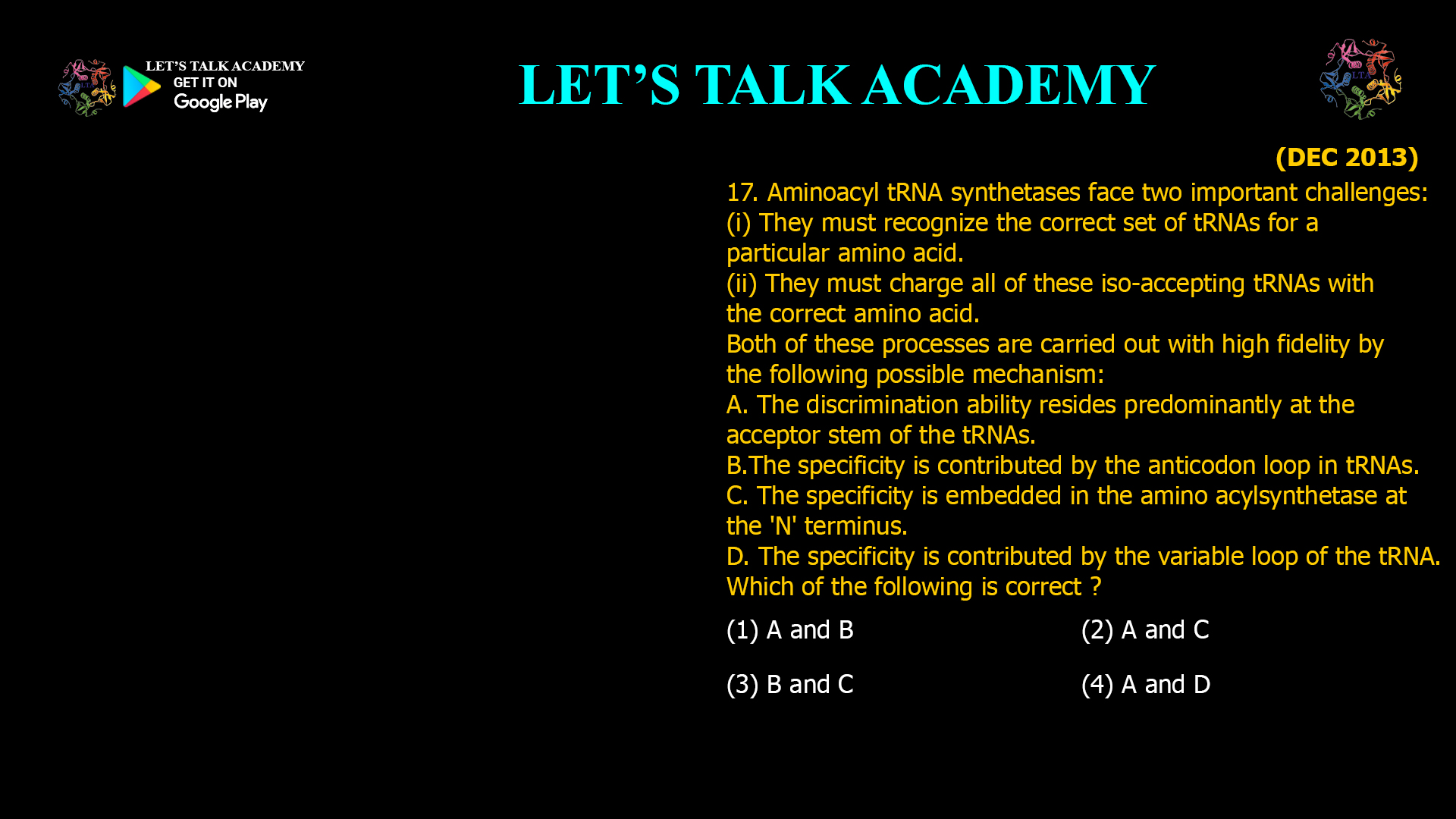- Aminoacyl tRNAsynthetases face two important challenges:
(i) They must recognize the correct set of tRNAs for a particular amino acid.
(ii) They must charge all of these iso-accepting tRNAs with the correct amino acid.
Both of these processes are carried out with high fidelity by the following possible mechanism:
A. The discrimination ability resides predominantly at the acceptor stem of the tRNAs.
B.The specificityis contributed by the anticodon loopin tRNAs. Thespecificity is embedded in the amino acylsynthetase at the ‘N’ terminus.
D. The specificity is contributed by the variable loop of the tRNA.
Which of the following is correct ?
(1) A and B (2) A and C
(3) B and C (4) A and DMechanisms of tRNA Recognition by Aminoacyl-tRNA Synthetases: Roles of Acceptor Stem and Anticodon Loop
Aminoacyl-tRNA synthetases (aaRSs) are essential enzymes that ensure the fidelity of protein synthesis by accurately pairing amino acids with their corresponding tRNAs. This specificity depends on the enzyme’s ability to recognize both the correct amino acid and the appropriate tRNA isoacceptors.
Key Recognition Elements in tRNA for aaRS Specificity
-
Acceptor Stem (A):
The acceptor stem, located at the 3′ end of the tRNA molecule, is a major determinant for aaRS recognition. It contains the universally conserved CCA sequence where the amino acid is attached. The enzyme interacts with the acceptor stem’s shape and sequence to discriminate among tRNAs. -
Anticodon Loop (B):
The anticodon loop contains the anticodon triplet that pairs with mRNA codons during translation. Many aaRSs also recognize specific nucleotides in the anticodon loop, contributing to tRNA identity and ensuring correct amino acid charging. -
Variable Loop (D):
The variable loop contributes to tRNA tertiary structure but generally plays a minor role in direct aaRS recognition compared to the acceptor stem and anticodon loop. -
Specificity in aaRS:
The specificity for tRNA recognition is embedded in multiple domains of the aaRS enzyme, often including the N-terminal region, which interacts with tRNA structural elements.
Evaluating the Statements
Statement Description Correctness A Discrimination resides predominantly at the acceptor stem Correct B Specificity contributed by anticodon loop; embedded at aaRS N-terminus Correct (anticodon loop role is valid; aaRS N-terminus often involved) D Specificity contributed by variable loop Incorrect (minor role)
Correct Option
(1) A and B
Supporting Insights
-
Structural and biochemical studies confirm that aaRSs use a combination of acceptor stem and anticodon loop recognition to achieve high specificity.
-
The acceptor stem provides a universal identity element, while the anticodon loop offers additional specificity, particularly among isoacceptors.
-
The variable loop influences tRNA folding but is not a primary determinant for synthetase recognition.
Keywords for SEO Optimization
-
Aminoacyl-tRNA synthetase specificity
-
tRNA acceptor stem recognition
-
Anticodon loop role in tRNA identity
-
Protein synthesis fidelity
-
tRNA-synthetase interactions
-
Translation accuracy mechanisms
-
tRNA structural elements
-
Aminoacylation process
-
Genetic code translation
-
Enzyme-tRNA binding domains
Conclusion
The fidelity of aminoacylation depends mainly on the recognition of the acceptor stem and the anticodon loop of tRNAs by aminoacyl-tRNA synthetases. These structural elements provide critical identity determinants that enable the enzyme to selectively charge the correct tRNAs with their cognate amino acids. The variable loop plays a lesser role in this specificity.
Correct answer: (1) A and B
-



